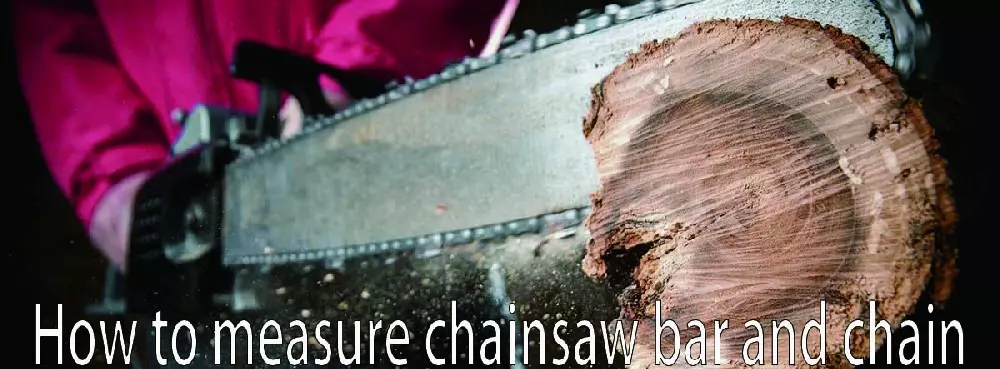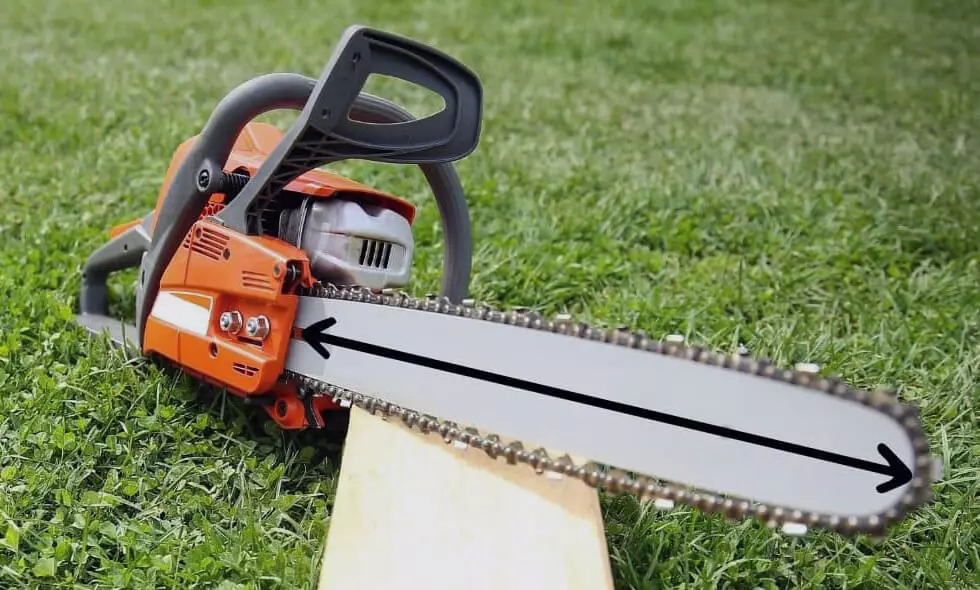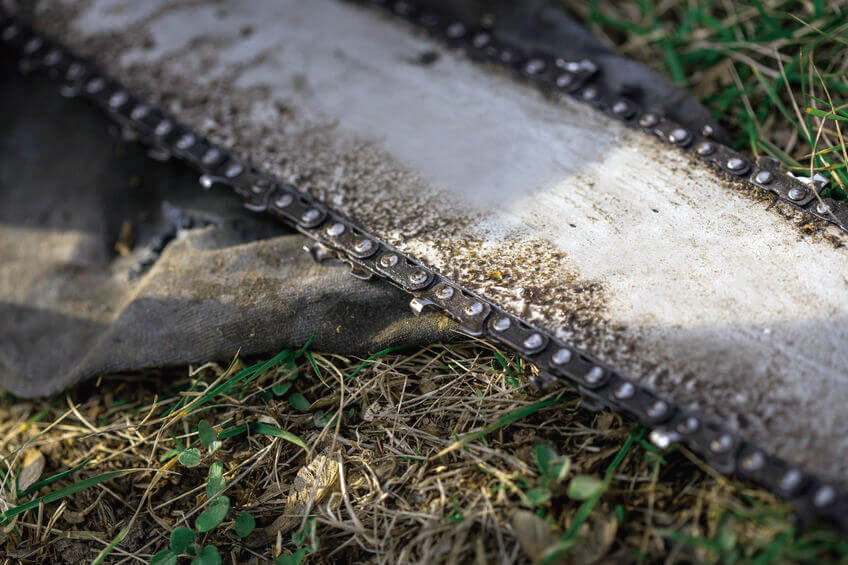16Dec 2022
table of contents

Chainsaw blades come in different sizes. Powerful chainsaws come with 20-inch blades, while less powerful chainsaws come with 18-inch or smaller blades. The easiest way to know the size of the bar is to check your chainsaw manufacturer's owner's manual. Each model comes with an owner's manual specifying the length of the bar in inches.
If you lose your user manual, don't worry. There is another way. The size of the bar can be determined by you.
Follow BISON's step-by-step guide to measure your chainsaw bar in minutes.
Called length refers to the chainsaw bar's usable length. It would help if you first determined the called length. The distance between the front tip of the saw and the clutter closet should be measured with a tape measure.
You must always round measurements to the nearest even number in inches. This is because chains are only indicated in even-numbered inches.
For example, if the length of the bar is 13 inches, you must treat it as 14 inches. Where it's 15 ¾ inches, think of it as 16 inches.
Even without an owner's manual, there are two ways to determine the size of your chain. BISON chainsaw parts will have measurements engraved on them. You can look up these numbers or measure the chain yourself.

Without a doubt, this is the easiest way to measure BISON chainsaw chain. You need to find three parameters to calculate the size of the chain. They are pitch, drive links and gauge. They are located behind the bar.
In this method, the dimensions of the chain are measured manually. To do this, you need to measure two parameters. They are gauge and pitch.
How to measure pitch
Pitch is the distance from the center of one drive link to the center of the other drive link. To measure pitch, calculate the distance between 3 consecutive rivets. Now, divide that value by 2. This will give you the pitch measurement. Most chain pitch sizes are ⅜ inches and 0.325 inches.
How to measure chain gauge
The width of the groove is called the gauge. The chain's attachment to the bar is located here. To measure a chain gauge, follow BISON steps below.
Use a screwdriver or any cleaning tool to clean the groove of the rod.
Try sliding a penny, quarter and dime into the groove.
Determine which one fits perfectly in the groove without applying any extra force.
If a quarter fits in the groove, the gauge of the chain is 0.063. If a penny or dime fits in the groove, the gauge of the chain is 0.058 and 0.050, respectively.
The pitch and gauge measurements will give you the size of your chainsaw chain.
Chainsaw bars wear more in the areas you cut most often, usually the lower edge: if you turn the bar regularly, both shoulders will wear evenly.
With use, burrs develop on the guide bar: it must be filed, or it can cause uneven saw travel and premature wear on the chain and guide bar itself.
Always file the sides of the grooves if they have different wear, i.e. different heights.
It is normal for the slide guides to slowly decrease in depth over the life of the rod. If wear is excessive or uneven, BISON recommend replacing the rod.
To see if you need to replace your chainsaw bar, follow these steps:
Check the chain with your fingertips by setting the chainsaw down on a flat area. If this "wobbles" a lot, it's time to replace the chainsaw blade (be sure to wear cut-resistant gloves when handling the chain).
Line up a ruler between the guide bar and the outside of the chain tooth: if there is a gap, the guide bar is in good condition; otherwise, it is worn out and must be replaced.
To keep your chainsaw bar in good shape for the long term, you can still follow some BISON recommended precautions, especially as you work; keep in mind to:
Check chain tension before and after cutting (to avoid abnormal track wear)
Adjust the flow of lube according to the type of wood being cut (to avoid overheating the rail at the point of greatest friction with the drive linkage)
Carefully sand the chain teeth regularly (reduces abnormal wear on the track and promotes clean and precise cutting)
Always cut straight and don't push the saw sideways: this will keep the grooves as intact as possible and won't deform the blade.
Chainsaw blades should only be used for cutting, not as hammers, levers, wedges, etc.
Not all electric chainsaw manufacturers make the same blades: If you need to replace your chainsaw blade, first follow the instructions in your chainsaw owner's manual to select a replacement from a manufacturer-approved product.
Following the manufacturer's recommendations helps ensure the product is used correctly. There are two reasons:
The joining surface of the new bar must be compatible with the chainsaw guard.
Only install bars and chains approved for your chainsaw: otherwise, the warranty will be void, and the manufacturer will no longer be liable for anything that may happen.

Now that you've determined your measurements, let's discuss the different blade shapes you can use.
The blade's form, which can be tailored to your particular line of work, impacts how well it cuts.
The following are modern cutting teeth with a brief description of each:
This chain features a strong square cut for the most efficient cutting. Due to the aggressive nature of this saw blade, it is best suited for sawing with sufficient power and for treating softwoods, as it splits the wood fibers easily and reduces work time. The saw blade's form causes these saws to have a greater danger of kickback.
There are several variants of the semi-chisel, some of which are called "chamfer chisels". Full chisels are shaped like the number "7," while semi-chisels have slightly rounded edges. The purpose of this shape is to provide an efficient medium-cut kerf that is less likely to snap back and maintain a sharp edge longer. They also stay sharp in dirty conditions, making this blade a true workhorse.
Chipping chains are fully circular and shaped to look like a question mark. This makes them the product with the lowest kickback risk and is excellent for working on dirty wood. The downside is that it has a slower blade.
Use tape to measure the distance from the front tip of the saw to the clutter closet. This is referred to as the chainsaw's called length and is the length that can be used. Round the figure now to the nearest even number. You will be given the chainsaw chain's length in inches.
The number of chainsaw bars indicates the gauge, pitch and number of drive links. These numbers are located close to the installation location on the back of the chainsaw bar. These numbers will give you the size of BISON chainsaw chain.
Chainsaw blades range in size from 12 inches to 40 inches. You can use an 18" bar on a 14" chainsaw. However, this is not advisable. When the blade is bigger than the chainsaw, the cutting performance won't be optimal.
No, it would be best if you did not run a chainsaw without a bar. The chainsaw's clutch and drive sprocket will disengage if you operate it without the bar. This will render the machine inoperable and could result in fatal injury.
The distance between two driving chain links is known as the chain pitch. Measure the distance between 3 successive rivets and divide the measurement by 2 to determine chain spacing. Most BISON chains are available in ⅜" and 0.325" pitch sizes.
As you can see, measuring chainsaw bars and chains is easy, even without an owner's manual. To calculate chainsaw bar size, you must measure the length and round it up to the nearest even number.
And you can utilize the marks on the bar or take your own measurements when sizing a chainsaw chain. Meanwhile, you have to calculate pitch and gauge to measure chain size.
inquiry form here
BISON BLOG, All the latest news and views from Bison Machinery.